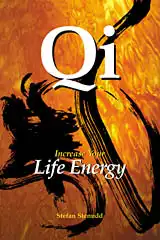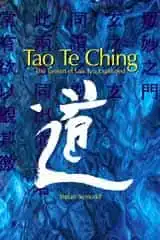|
Tao Te Ching
THE TAOISM OF LAO TZU
|
Tao Te Ching
|
The Book
The Taoism of Lao Tzu Explained. The great Taoist philosophy classic by Lao Tzu translated, and each of the 81 chapters extensively commented. Click the image to see the book at Amazon (paid link). |
Be Like Uncarved Wood
Lao Tzu is fond of the image of the uncarved wood as a symbol of simplicity and humility. He uses it several times in his book. A piece of wood is as simple as something can ever be, but it contains numerous possibilities. When carved, it can become almost anything you want. Still, nothing surpasses the natural state of wood before the knife is put to it.
We should not think that we improve the wood by our carving. We just change it. That way it may become more useful to us, but in no way finer than it was in its original state.
This is even more obvious if compared to what it was when still part of a living tree, where it participated in the wonderfully complex process of life and growth. When cut from that tree it becomes a log. A chunk of material, passively reduced to whatever we make of it, or abandoned and decomposed.
Whatever we do to wood, it can never be as splendid as it was on the living tree.
Polarities
In this chapter, Lao Tzu also uses quite strong polarities, such as honor and disgrace, preferring the latter. That might be hard for most people to accept. But insisting on being honored is a mentality that surely leads to disgrace.The one who accepts disgrace, on the other hand, will be honored already by this.
We frequently witness examples of this in modern day politics, where pompous dignitaries fall from grace when they refuse to admit any wrongdoings, although evident. Those who confess humbly and regretfully, on the other hand, can find themselves even more praised than ever before. We do love to forgive a repenting sinner.
Choosing the darkness before the bright seems even more absurd to us, because we have a tradition of comparing the latter to salvation and the former to its opposite, damnation. It's deeply rooted in the Christian vocabulary, since the time when Jesus called himself the light. Consequently, we call his counterpart the prince of darkness.
But the opposites mean something else to Lao Tzu. Darkness refers to the dim valley compared to the brightly lit mountain, the shady side, yin, instead of the sunny side yang. Tao Te Ching keeps repeating the ideal of yielding, so the sage modestly steps out of the light, into the shadows, and never insists on attention.
The Chinese words used can also be translated white and black, but the meaning is the same. Choosing the latter shows exemplary character, because it proves that you are not driven by personal gain.
The manly and womanly are opposites of the same kind as light and dark. Yang is regarded as manly and yin as womanly, in the Chinese tradition. In the symbol, yang is the white field hovering over the black yin, like Heaven rises above Earth.
Anyone choosing the former will elevate himself over others, thereby losing compassion for them. It's impossible to lift everyone else to an elevated position, but if you choose the lowest seat, then others will fall effortlessly into your lap.
Usually, Lao Tzu compares this yielding to the motherly, but here he lets us know that it also brings out the child in us.
When you let go of your ambitions, the world becomes fresh before your eyes. You see it for what it is, instead of what you want from it. That's the eye of the child.
The Virtuous Past
The virtue mentioned several times in this chapter is Te, part of the book's title. This virtue being eternal refers to its ancient tradition. It could not be eternal without stretching into the past as well as into the future.In the time of Lao Tzu, the ancient past was regarded with much more reverence than the present and the future. So, that side of eternity was valued higher. Virtue of recent origin would be regarded as preposterous.
Antiquity, not only in China, valued its history tremendously, but saw little reason to ponder the future at any length. We tend to do the opposite, because we believe the future to be one of continued improvement – at least its potential.
If you make the right choices by following the ancient virtue, you become like a child, simple as uncarved wood, and thereby boundless. You lose the limits of preconception, the prejudice brought on by wants and ambitions.
It's a state of mind, which is brought on by virtuous choices – not for the sake of reaching it, but because of these choices being the virtuous ones. That's why virtue fills you, never falters, and never deserts you. True virtue needs neither reason nor rewards. It's just the way it should be, which is according to the Way.
Put to Use
Lao Tzu ends the chapter with what seems to be some play with words. The sage is like uncarved wood, which is put to use when split. But when the sage is put to use, he takes command. Some serve and some lead. It's natural for the sage to lead, even when he is reluctant to do so.He will lead even when others expect him to serve. He points the Way. How else to use him?
The sage knows to remain in the state of uncarved wood, utter simplicity, in whatever grand tasks he gets involved. He is not split, either by distraction or ambition, but remains with what we call the whole picture.
That's how the world should be treated. It's a whole that must not be split into this and that. All things are connected to the whole, and malfunction when separated from it.
This is something we are right now starting to understand about the world we live in. We give this knowledge a fancy new name, ecology, but it's been known for ages.
NEXT
Tao Te Ching Explained
Preface
Introduction
Literature
translated and explained by Stefan Stenudd.
1 |
2 |
3 |
4 |
5 |
6 |
7 |
8 |
9 |
10 |
11 |
12 |
13 |
14 |
15 |
16 |
17 |
18 |
19 |
20 |
21 |
22 |
23 |
24 |
25 |
26 |
27 |
28 |
29 |
30 |
31 |
32 |
33 |
34 |
35 |
36 |
37 |
38 |
39 |
40 |
41 |
42 |
43 |
44 |
45 |
46 |
47 |
48 |
49 |
50 |
51 |
52 |
53 |
54 |
55 |
56 |
57 |
58 |
59 |
60 |
61 |
62 |
63 |
64 |
65 |
66 |
67 |
68 |
69 |
70 |
71 |
72 |
73 |
74 |
75 |
76 |
77 |
78 |
79 |
80 |
81 |
Tao Te Ching Explained
James Legge's Tao Te Ching
Aleister Crowley's Tao Te Ching
The 1st Chapter of Tao Te Ching in 76 Versions
Lao Tzu — Legendary Author of Tao Te Ching
My Taoism BooksClick the image to see the book at Amazon (paid link).
The Taoism of Lao Tzu Explained. The great Taoist philosophy classic by Lao Tzu translated, and each of the 81 chapters extensively commented. |
About Cookies
My Other Websites:
I Ching Online
The 64 hexagrams of the Chinese classic I Ching and what they mean in divination. Try it online for free.
Qi Energy Exercises
The ancient Chinese life energy qi (chi) explained, with simple instructions on how to exercise it.
Life Energy
The many ancient and modern life force beliefs all over the world explained and compared.
Taoismen på svenska
Other Books by Stefan Stenudd
Click the image to see the book at Amazon (paid link).
 Cosmos of the Ancients
Cosmos of the Ancients
The Greek philosophers and what they thought about cosmology, myth, and the gods.
 Qi — Increase Your Life Energy
Qi — Increase Your Life Energy
The life energy qi (also chi or ki) explained, with exercises on how to awaken, increase and use it.
 Aikido Principles
Aikido Principles
Basic concepts of the peaceful martial art. Aikido principles, philosophy, and fundamental ideas.
 Life Energy Encyclopedia
Life Energy Encyclopedia
Qi, prana, spirit, ruach, pneuma, and many other life forces around the world explained and compared.
 Archetypes of Mythology
Archetypes of Mythology
Jungian theories on myth and religion examined, from Carl G. Jung to Jordan B. Peterson.
 Stefan Stenudd
Stefan Stenudd
About me
I'm a Swedish author and aikido instructor. In addition to fiction, I've written books about Taoism and other East Asian traditions. I'm also an historian of ideas, researching ancient thought and mythology. Click the image to get to my personal website.Contact

 Tao Te Ching
Tao Te Ching Tao Quotes
Tao Quotes Fake Lao Tzu Quotes
Fake Lao Tzu Quotes